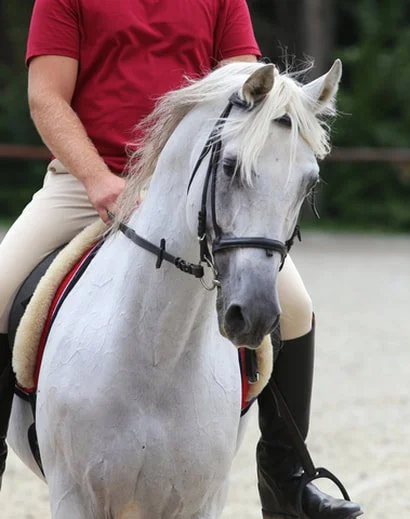I get quite a few riders who come to clinics who have a background in dressage to some degree. Perhaps the most challenging thing most face at one of my clinics is my suggestion they let go of the idea of using “inside leg to outside rein” when turning or circling. The use of inside leg to outside rein is pervasive in the dressage world and one of the first things that is taught to a young rider. I was taught it when I was a teenager. There are many times when the outside rein should be applied, but creating a balanced turn or circle is not one of them.
For the purposes of this essay, I am going to confine the discussion to the use of the outside rein. Perhaps I will talk about the rider’s inside leg in another post.
When I ask people why use the outside rein to help a horse turn to the inside there are two common explanations.
1. First, the outside rein blocks the horse from overbending its neck in response to the inside rein. In other words, the inside rein flexes the horse's neck to the inside, but the outside rein blocks it from bending too much.
2. Secondly, when turning or circling, many horses are unbalanced and will drift to the outside of the turn. To keep the horse on the line of the turn or circle, the outside rein can be applied to block the horse’s shoulders from drifting to the outside. In other words, when circling to the left the outside rein can stop the horse’s shoulders from outside of the line to the right, as if the outside rein was a fence.
(Some teachers will tell students to use the outside rein to encourage a horse not to fall on its forehand. However, that is a totally other topic and best saved for another time).
Q. What do these two explanations have in common?
They are both examples of a horse not accurately following the feel of the inside rein.
Q. Why doesn’t the horse follow the feel of the inside rein?
Because the rider is using the reins to only move the feet and ignoring directing the thought.
I will remind you of the two axioms, “a horse is always trying to do what its strongest thought is” and “everything a horse does begins with a thought to do it.”
So when it is necessary to apply the outside rein to maintain balance and straightness it is because the inside rein is only being used to move the feet and body and NOT to help a horse have the idea to turn or circle. The connection between the horse’s mind and the inside rein is broken.
Let’s look at the two explanations for using the outside rein.
1. The outside rein blocks the neck from overbending.
If the connection to the inside rein was soft and accurate, the degree of the bend of the horse’s neck would be equal to the amount of feel on the inside rein. A stronger feel equals more bend and less feel will result in less bend.
2. The drift of the shoulders to the outside of a turn or circle is caused by the horse’s mind thinking to the outside. It’s a resistance to the feel of the inside rein instead of going with the feel with its thought. It’s like a feel on the lead rope causing a horse to pull back. But instead, it is the feel on the inside rein causing the horse to pull to the outside.
Imagine buying a new car. The salesman tells you, “when you want to turn left, turn the steering wheel to the left but make sure you have a friend in another car on your right lane who can bump into you when the car drifts to the right.” Would you really want to drive that car?
To summarise, the outside rein is a bandaid to cover up the errors caused by a horse not understanding how to follow the feel of the inside rein with its thought. The outside rein addresses only the symptom of crookedness when a horse is turning, not the cause. It does work to keep a horse on the line of the turn, but it does not ever fix the problem of a horse not following with the feel of the inside rein.
Sometimes a student will explain to me that almost the entire world of dressage is committed to the outside rein when turning a horse. People have been using it for hundreds of years. The great masters of the French, Italian, Russian, Spanish, German, and English schools have preached the use of the outside rein. So who am I to say otherwise?
I think I know why the use of the outside rein became popular, but I can’t explain why it is still popular. Tradition? The fact that the outside rein works to prevent overbending and drifting to the outside so why look further? I don’t know.
But I do know that teaching a horse to follow the feel of the inside rein makes the use of the outside rein redundant and leads to a softer, happier, more comfortable ride. I know this. It is not a theory. I’ve proved it to myself and to students over many many thousands of rides.
No doubt some of you will be dismissive of this post, perhaps angry or offended. That’s fine. But I urge you to make sure that your reasons for relying on the outside rein to create balanced turns are better than my reasons for looking to teach a horse to follow the feel of the inside rein with its thoughts to create balanced turns.
Right rein (outside rein) being applied to the left turn

